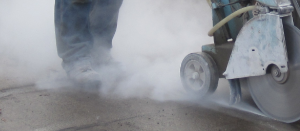In 2016 OSHA issued the standard 1910.1053 for General Industry in order to protect workers from exposure to respirable silica dust. The silica standard was initially to be enforced on June 23, 2016 but OSHA delayed enforcement to June 23, 2018.
The silica standard applies to all General Industry employers unless:
- The employer has objective data that can demonstrate that the exposure to respirable silica dust will remain, under any foreseeable working condition, below the action level of 25 µg/m3, calculated in an 8-hour time weight average (TWA), or
- The employer chooses to:
- comply with the construction silica standard (please see also our blog on OSHA silica standard for construction 29 CFR 1926.1153) AND
- tasks performed are indistinguishable from a construction task listed on Table 1 of the construction standard, AND
- the tasks will not be performed on regularly basis in the same environment and conditions
In order to conform to the silica standard for general industry, each employer has to comply with the following requirements:
- Employers must ensure that the concentration of silica dust, for each employee exposed, is maintained below the Permissible Exposure Limit (PEL) of 50 µg/m3, using engineering control, work practice and good housekeeping. If such methods are not sufficient to guarantee that the exposure is below the PEL, employers must provide appropriate respiratory protection.
- Silica Exposure Assessment. Employers must assess the exposure for each employee expected to be exposed above the Action Level of 25 µg/m3, with one of the following methods:
- Performance Option. The employer must perform the assessment on the basis of air monitoring data or objective data (from industry-wide surveys reflecting workplace condition assessed).
- Scheduled monitoring option. Employer must perform the assessment through initial air monitoring samples and subsequent samples based on the initial assessment.
- Regulated Areas. Employers must demarcate and limit the access to regulated areas, where the exposure is expected to be above the PEL. Appropriate respiratory protection must be used in these areas.
- Medical surveillance. The employer must offer initial medical examination to every employee exposed to concentration of silica at or above the Action Level for more than 30 days in a year, and then perform periodic examination at least every 3 years or more frequently as per PLHCP (Physician or other licensed health care professional) Employer and PLCHP must cooperate to assure that each employee receive adequate medical examinations and be informed on the results.
- Training. Employers must inform and train all employees exposed to silica dust above the action level (25 µg/m3), and include the respirable silica in the Hazard Communication Program (29 CFR 1910.1200 see our previous silica exposure post)
- Recordkeeping. The following records must be maintained to show compliance with the provisions of the silica standard:
- Exposure measurements (if any);
- Training;
- All objective data relied upon to comply with the silica standard;
- Medical surveillance.
Environmental Health and Safety Consultants
Walden Environmental Engineering provides a variety of services related to OSHA compliance. Walden can assist you in determining the applicability of the silica standard for your facilities, and achieving compliance with all the requirement that the standard entails, before the effective date of June 23, 2018.
Call us at 516-624-7200 for a free consultation to discuss any issue about the OSHA silica standard 1926.1053 for your facility or about any of the other Environmental Health and Safety (EHS) engineering services we provide.

